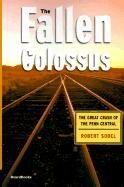|
|
|
|
||||||

|
The Fallen Colossus
By Robert Sobel 2000/08 - Beard Books 1893122883 - Paperback - Reprint - 384 pp. US$34.95 The Penn Central debacle has much to teach investors, businessmen, and financiers about giant corporations caught in economic recessions or industries suffering a slow decline. Publisher Comments
This is the story of the 1970s bankruptcy of the Penn Central Railroad, the nation's foremost transportation company. The demise of the Penn Central, which took the form of a death struggle for six years, was a catalyst for legislation that set the stage for future partnerships between the private and public sectors, a relationship enjoyed by other segments of the transportation industry. From the back cover blurb: The Fallen Colossus is the story of the 1970s bankruptcy of the Penn Central Railroad, the nation's foremost transportation company --- an entity that resulted from the largest merger in history. The death struggle continued for six years amidst public and Congressional apathy. This is carefully chronicled in Sobel's book along with the blunders of inept management and of the Nixon Administration. The demise of the Penn Central was a catalyst for legislation which set the stage for future partnerships between the public and private sectors, a relationship enjoyed by other segments of the transportation industry. The Penn Central debacle had much to teach the investor, businessmen and financiers of the time about giant corporations caught in economic recessions or industries suffering a slow decline. A Detailed History,
April 17, 2001 The Fallen Colossus is, on the surface, the story of the failure of the Penn Central Railroad. Sobel, however, takes great pains to chronicle the development of transportation in America. Starting with the the very beginning of freight and passenger transit by roads and turnpikes, through the canal era, he ultimately provides a thorough treatment of the eastern lines (and even a bit beyond when he discusses the impact of air and highway transport on the rail industry). The book is, at times, tedious with figures and balance sheets, though they are important to understanding railroads as a business and as a contributing factor to the near catastrophic collapse of the 1960s. The book was written as the Penn Central mess was just being cleaned up with the advent of Conrail and Amtrak. It is notable that the author notes the overly optimistic estimate by the directors of the new Conrail organization that they expected to take these bankrupt railroads and make them profitable by the 1980s. The author and others doubt this potential. Ironically, it worked and Conrail was reasonably successful where the Penn Central failed. Overall, an informative, if not lively, read for those looking into how not to run a railroad. One curious item is the generic cover art. It cannot possibly be part of what
was the Penn Central. The scene is one of flat desert with straight rails
running toward a series of treeless hills on the horizon. It looks more like the
Southern Pacific as this scene couldn't possibly be Appalachia. Details,
details.
|
|
|
|
home
| about us
| contact us
| related
sites |